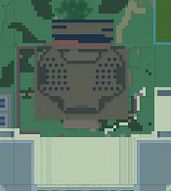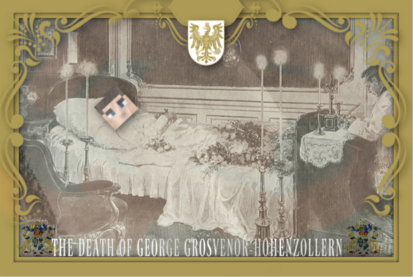George Grosvenor
George Gerald Hohenzollern Grosvenor, 1st Duke of Westminster, Lord Hanover, Prince of Italy, Prince of Imperial Germany was a businessman, political-active aristocrat who resided in Grosvenor House, London.
- The Founder of The House of Grosvenor-Hohenzollern
Early Life: The Duke Of Westminster was born in the outskirts of Plymouth in Devonshire, being that he was related to the The 1st Duke of Devonshire, George Cavendish. The Duke would live in Devonshire House, spending his time studying art and music at Plymouth Marjon University receiving degrees in literature, art and music with his diploma in 1820. The Duke did not obtain any other title than '' Lord Cavendish-Hohenzollern '' until his adulthood.
Adulthood: When he turned 18, the duke moved to London to watch the flourishing capital of Britain at its architectural rising, it was at this time where he received the heraldry title of '' Duke of Westminster ''. As the years went by the Duke contributed to the city with his architectural ideas and plans. He drew the Slyprince Opera House, The National Museum of Britain, and many more buildings within London. But the very finest that he drew was his own residence, Westminster House, a 34 roomed neoclassical gilded building of quartz-terracotta decorated rooms and interiors facing Buckingham Palace; The Duke spent the rest of his days in London, Westminster and met a woman which name no-one knows and produced a new heir to his title, Alexander Julian Spencer Hohenzollern Cavendish Grosvenor. The Duke was banished from Britain for national treason as he was found walking around the streets of London griefing the many beautiful buildings in a sort of trance. He explained the situation and was given a second chance by King MineHero43, and again contributed to London's growth.
Architecture:
The Duke was as well as a very fine lover of art and music, largely enthustiactic about the art of architecture. The Duke drew many architecturial pieces throughout his lifetime. Some of them are listed here. The Duke started the '' Georgian '' architectural wave, which is very present in European capitals such as London and Berlin.
Westminster House
As seen here from the side, Westminster House consists of lavish french gardens, built in a Georgian style in the middle of London. Westminster House is the largest private residence in London besides Buckingham Palace. Westminster house's interior consists of various types of finely-decorated and furnished quartz and terracotta made rooms, built in a neoclassical, rococo and Victorian manner complete with fine tapetries, large louis xiv beds, byzantine bathrooms, an inside svimming pool, underground vaults, stables, and a proper ballroom. All these rooms make up the large mansion that The Grosvenor Family lives in. The mansion has an estimated 35 rooms and took half a year to build. A proper stately home indeed. The Duke did not live to see its full construction, the manor was finished by the Grosvenor heir, General Guineapigplays, King Erwinning of Italy and Prime Minister Angloist of Britain.
The Royal Slyprince Theatre
As seen on the picture, The Royal Slyprince Theatre is a very grand theatre indeed. The Duke of Westminster was comissioned to draw this fine and proper royal majestic venue for the remembrance of the late Prime Minister SlyPrince and for the purpose of bringing a new social spot to London, in which the British culture could flourish through a variation of plays, musicals, concerts, speeches and other cultural events. The theatre is also drawn in the Georgian style, with inspiration from Byzantium and the Roman Empire, that you can see, if you look at the gildedly quartz and gold decorated ceiling of the outdoor balchony of the theatre. The theatre interior was drawn to host the whole of London and more, containing more than 45 seats in total. The interior is complete with a large red curtain, an orchestra grave, a Royal seating box and very nice seating boxes on the side for important individuals such as foreign diplomats, state representatives and nobility. A very cultural construction indeed.
The Foreign Ministry & Royal Court Office Building
Disappearance
Around this time an old friend asked Grosvenor to help him with constructing his new town of St. Petersburg. George told Guineapigplays to look after Westminster Hall whilst he was away. He frequently updated Guinea on St. Petersburg's progress, but suddenly, the updates stopped. This worried Guinea. The Metropolitan police launched an investigation. Grosvenor was found in St. Petersburg, wounded from a fall he had when he was on some scaffolding. The Duke was taken back to London to recover. The Duke was in St. James Hospital was treated with the best care.
Death
After The Duke of Westminster returned from St. Petersburg, having The Romanovs being financially ruined, leading to the collapse of St. Petersburg Grosvenor was still hardly injured from the fall from overlooking his architectural wonders. Not only was Grosvenor injured by the fall, while travelling by carriage, through Europe, Grosvenor caught tubercolose, while staying in Poland and was hurriedly signed in at St. James Hospital, when back in London. The doctors did not know of his turbercolose, so we did not receive any treatment other than for his head. HG, The Duke of Westminster passed away by sleep in his own residence, Westminster House when back from the hospital. The Duke became 79 years old and left everything to his brother, General Guineapigplays of Hanover and his family fund.
Place of Burial
HG, The Duke of Westminster is privately buried in his residence, Westminster House, London.


